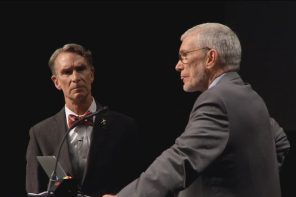According to a new study, the economic value of religion in America is $1.16 trillion per year, or a little less than the GDP of Russia.
The estimate comes to us from a father and daughter team, Brian and Melissa Grim. Brian is an associate scholar at Georgetown and the founder and director of the Religious Freedom and Business Foundation, which aims to “[educate] the global business community about how religious freedom is good for business.” Melissa is an RFBF research fellow at the Newseum Institute.
Their $1.16 trillion estimate is a staggering amount of money—something like 7% of the United States’ GDP. It’s also, on reflection, a somewhat silly figure. How do you possibly estimate the economic value of something as gigantic and amorphous as American religion? And even if you do pin down a number, what does it tell you? That religious organizations should list themselves on Nasdaq? That the Methodists really need to step it up in FY 2017? That religious groups handle a lot of cash?
That last one isn’t a secret: we already know that religious institutions take in large sums. The Grims are trying to turn a truism into a number. That’s always a delicate exercise. At best, figures can help us grapple with the experience of living in a mass society. But they can also produce a kind of false certainty that obscures more than it clarifies.
So, does religious activity really account for 7% of the U.S. GDP? Perhaps. It depends on how you define religion. By any reasonable measure, the Grims’ $1.16 trillion estimate is high, though elements of their research do highlight the sheer amount of cash that flows through faith-oriented organizations—much of it difficult to track.
In their tallies, Grim and Grim actually come up with three different estimates for the impact on religion on the American economy.
The lowest estimate—$378 billion—adds up the revenues of religious educational institutions, charities, media organizations, and healthcare networks, and adds that to the multibillion dollar kosher and halal foods industry and to an estimate of the total revenue of American religious congregations. To get that final number, the Grims took one estimate of the total number of congregations in America (344,894) and multiplied it by another estimate of the average revenue of each ($242,910).
Depending on how you look at it, $378 billion is a lot of money, or it’s not very much money at all. It’s more than the net worth of Bill Gates, Jeff Bezos, Mark Zuckerberg, and Warren Buffet, combined. It’s also barely 2% of the country’s GDP. There have been years when Exxon alone pulled in more cash.
Brian Grim said that, after they circulated this number among some colleagues, most thought it was way too low. In an interview with RD, Grim was blunt: “I think [this estimate] is wrong.”
The second estimate—$1.2 trillion—is the one that has been appearing in headlines and press releases, and it’s the one the Grims argue is most accurate. To get this number, they took the first figure, $378 billion, and then added the estimated economic impact of religious congregations and charities on their communities, plus the revenues of “businesses with religious roots,” a category that includes a few predictable choices (Hobby Lobby, Chik-Fil-A), and a few less conventional ones (Walmart, Whole Foods Market).
The Grims’ third and highest estimate, $4.8 trillion, includes all the household income of all the Americans who tell Pew researchers they’re affiliated with a specific religious tradition, though even Grim admits that method is “hard to defend.”
Let’s focus for a minute, though, on that $1.2 trillion number. (Actually, $1.16 trillion, but hey, what’s a difference of $40 billion, really?).
Here’s the most important thing to realize: according to the Grims, Walmart accounts for one-quarter of the nation’s religious GDP. Of that $1.16 trillion estimate, $422 billion comes from a list of “religion-based companies,” $279 billion of which comes solely from Walmart.
The company is a behemoth. The company also does not mention religion at all in a brief overview of its history, its corporate ethics page, or the company values posted on its website. To count 100% of the company’s revenue as “faith-inspired” seems pretty misleading.
When I brought this issue up with Brian Grim, he said that he and Melissa chose companies “that were identified by other scholars as having a clear religious connection. With Walmart, there were numerous scholarly works that look at that and made the conclusion that really religion was a critical aspect within the company—within the leadership of the company.”
It’s true: scholars have dissected the protestant origins of Walmart.
But scholars have made a similar argument about all of capitalism. There’s no question that Christian ideas have shaped American business practices, just as American business practices have influenced churches. Lumping the annual revenues of Walmart in with synagogue dues, donations to the Salvation Army, and Catholic hospitals seems like a stretch.
And if you look at other corporations, and the criteria used to include them, the territory becomes even murkier. Take Trijicon, for example, chosen from a Deseret News listicle, “20 companies with religious roots.” Deseret News included Trijicon in the list because the company “inscribed coded biblical references on high-powered rifle sights used by the U.S. military.” That’s it. Other than the founder’s purported religious beliefs, its inclusion is arbitrary. Why not include Ebay, whose founder Pierre Omidyar is a Buddhist, or any of Sheldon Adelson’s businesses?
Trying to draw a line between “business with religious roots” and “everything else in global capitalism” is, quite simply, an absurd exercise.
So why bother with this kind of research, anyway? Do these numbers tell us anything useful?
For one thing, a big economic impact number might jibe with the goals of the elder Grim’s Religious Freedom and Business Foundation. But more generally, as the Grims see it, their study’s intended message seems to be something along the lines of Hey, religion does good things!
“A lot of the messages [about religion] that come through focus—rightly—on some of the problems related to religion, such as clergy sex abuse scandals or religion-related terrorism,” Brian Grim told RD. “I think a study like this helps give a better-balanced understanding of the impact of religion on American society today.”
But equating “the production of economic value” with “positive impact on society” seems disingenuous.
And that apparent desire to overcorrect may have led to the study’s biggest problem. Other than a brief mention in their introduction and conclusion, the study doesn’t consider ways in which religion might detract from economic production. Devoting a half dozen sentences to the omission of the potential downside of religion in a study purporting to show “The Socio-economic Contribution of Religion to American Society” is a bit like presenting investors with your sales and failing to calculate your overhead.
Walmart may, in fact, be the perfect example of why the omission of any negative impact is more than just a “limitation.” As has been well documented, Walmart’s impact on the economy is anything but straightforward. It may have a stellar bottom line, but it’s the largest of a group corporations that, according to a recent UC Berkeley Labor Center study, taken together cost U.S. taxpayers nearly $153 billion per year (yes, that is a “b” and that is “per year”). According to the Nation, single Walmart Supercenter costs taxpayers between $904,542 and $1.75 million per year in public assistance money.”
The Grim’s data may also raise questions about the future. Plenty of commentators have fretted over the rise of the so-called Nones—Americans who decline to affiliate with a particular religious group—but few have speculated that religious disaffiliation could make ripples in the economy. “Is this economy endangered with people being less religiously affiliated, given that religion is such a positive contributor to overall social and economic well-being?” asked Grim during our conversation, when I brought up this possibility. “I think that is a concern.”
The implication that the rise of the Nones would hurt the economy depends, really, on how you understand religion. The Grims’ analysis, for example, doesn’t include much of the spiritual wellness industry, such as yoga classes. As I’ve argued before, even if people do disaffiliate from traditional religious organizations, they may simply migrate toward other profit-oriented meaning-making structures like SoulCycle or CrossFit. And it’s not clear whether religious disaffiliation would bankrupt, say, a Baptist hospital.
Studies like the Grims’ produce wildly ballpark figures, and they put the sheen of science on something that, ultimately, comes down to some very subjective questions. What is religion? What makes an institution religious? What makes a person’s or company’s motives religious, as opposed to something else? Should churches cite their economic impact on the neighborhood alongside other figures about their social work? Does this money-talk muddy spiritual motives?
Despite the study’s flaws and the Grims’ tendentious conclusions, this research is a good reminder that religious institutions handle so much cash. Religion journalists and scholars seldom look at the financial side of worship, and financial analysts don’t spend too much time thinking about faith. A dearth of data contributes in both cases, no doubt, due in part to special exemptions in the tax code that allow congregations to disclose far less information about their finances than other kinds of nonprofits.
Still, when it comes to journalists and scholars writing about the role of religion in America, we’d all do well to remember to follow the money.
* * *
Also on The Cubit: Inside the new economy of spiritual fitness





